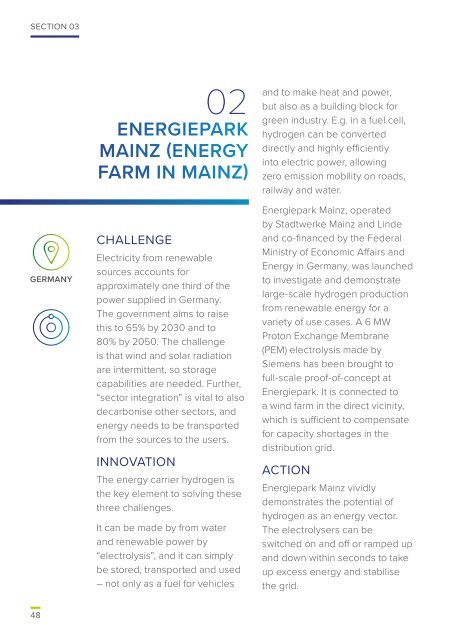MI 2020 Solutions FINAL
You also want an ePaper? Increase the reach of your titles
YUMPU automatically turns print PDFs into web optimized ePapers that Google loves.
SECTION 03<br />
FUELS<br />
GERMANY<br />
02<br />
ENERGIEPARK<br />
MAINZ (ENERGY<br />
FARM IN MAINZ)<br />
CHALLENGE<br />
Electricity from renewable<br />
sources accounts for<br />
approximately one third of the<br />
power supplied in Germany.<br />
The government aims to raise<br />
this to 65% by 2030 and to<br />
80% by 2050. The challenge<br />
is that wind and solar radiation<br />
are intermittent, so storage<br />
capabilities are needed. Further,<br />
“sector integration” is vital to also<br />
decarbonise other sectors, and<br />
energy needs to be transported<br />
from the sources to the users.<br />
INNOVATION<br />
The energy carrier hydrogen is<br />
the key element to solving these<br />
three challenges.<br />
It can be made by from water<br />
and renewable power by<br />
“electrolysis”, and it can simply<br />
be stored, transported and used<br />
– not only as a fuel for vehicles<br />
and to make heat and power,<br />
but also as a building block for<br />
green industry. E.g. in a fuel cell,<br />
hydrogen can be converted<br />
directly and highly efficiently<br />
into electric power, allowing<br />
zero emission mobility on roads,<br />
railway and water.<br />
Energiepark Mainz, operated<br />
by Stadtwerke Mainz and Linde<br />
and co-financed by the Federal<br />
Ministry of Economic Affairs and<br />
Energy in Germany, was launched<br />
to investigate and demonstrate<br />
large-scale hydrogen production<br />
from renewable energy for a<br />
variety of use cases. A 6 MW<br />
Proton Exchange Membrane<br />
(PEM) electrolysis made by<br />
Siemens has been brought to<br />
full-scale proof-of-concept at<br />
Energiepark. It is connected to<br />
a wind farm in the direct vicinity,<br />
which is sufficient to compensate<br />
for capacity shortages in the<br />
distribution grid.<br />
ACTION<br />
Energiepark Mainz vividly<br />
demonstrates the potential of<br />
hydrogen as an energy vector.<br />
The electrolysers can be<br />
switched on and off or ramped up<br />
and down within seconds to take<br />
up excess energy and stabilise<br />
the grid.<br />
The hydrogen produced can be stored<br />
and either converted back to electricity<br />
later, or used for other purposes like<br />
mobility, heating or as an industrial<br />
feedstock.<br />
The Energiepark constitutes the world’s<br />
first multi-Megawatt PEM electrolyser<br />
installation; previously the technology<br />
had been used at much smaller scale,<br />
e.g. at hydrogen fuelling stations. In May<br />
2018 it is still the world’s largest system<br />
by peak capacity.<br />
POTENTIAL<br />
In the future similar plants could work in<br />
various locations to stabilise the grid and<br />
By Energiepark Mainz<br />
augment the energy transition by sector<br />
integration. To achieve this the concept<br />
needs to reach economic viability; for<br />
that, energy regulation and political<br />
support should be tailored accordingly.<br />
In addition, the production, storage<br />
and distribution of hydrogen should be<br />
standardised, electrolysers capabilities<br />
further improved and extended hydrogen<br />
applications actively developed and<br />
pushed.<br />
USEFUL LINKS:<br />
energiepark-mainz.de<br />
48 49


